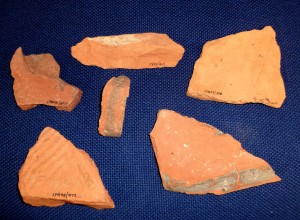 The Department of Archaeology, Anthropology and Forensic Sciences is about to start a new project that uses a non-destructive method to examine museum specimens in order to determine their possible source.
The Department of Archaeology, Anthropology and Forensic Sciences is about to start a new project that uses a non-destructive method to examine museum specimens in order to determine their possible source.
The project will examine the stone and ceramic (brick and tile) industries of Roman Britain using portable X-ray fluorescence (pXRF) to help us identify where the quarries and tile kilns were located. This work forms the centrepiece of a knowledge exchange network with two leading museums in southern Britain (Roman Bath Museum and Fishbourne Palace Museum) who will use our results in innovative interpretations, including new displays and museum learning centres. This will ensure maximum added value to blue-sky research that will quickly feed back into public engagement with science and technology. It is funded by a recently awarded HEIF5+1 grant.
The research supports knowledge exchange activity with SMEs by building on links established by BU over many years with archaeological museums in southern Britain. Museums are a vital component of our local economy. For instance, Roman Bath Museum attracts over 1 million visitors per annum, making it one of the most popular museums outside London. Its importance not only to Bath but to the wider regional economy is well recognised. But museums must constantly renew themselves and offer an exciting educational package to visitors of all ages, hence the Museum Association has made collaborations between universities and museums one of its key priorities, and as such this project should be seen as a model of best practice.
While XRF has been used for some time in archaeology, the recent development of portable XRF has added a whole new dimension. We no longer have to bring samples to the lab, but the lab can come to the museum, examining stone and ceramic samples that are on display. The Dept of Archaeology, Anthropology and Forensic Sciences is at the leading edge of this development and has already made a reputation using pXRF on archaeological soils, metals and for forensic analyses. However, work by science-based archaeology departments into Roman building material (i.e. limestones in this case) and ceramic building material has been limited. This is therefore an opportunity to work up a methodology and to apply it to the early Roman settlement of Britain. Questions about how and where production (both quarrying and kiln-works) was organised can be addressed once answers to questions about the location of these production centres have been examined. This has impact beyond Roman Bath and Roman Fishbourne, as it has implications for the concept of ‘Romanisation’ of Britannia in the early years of the Roman Conquest of Britain.
For further details, please contact Professor Mark Brisbane.











 BU academic publishes in online newspaper in Nepal
BU academic publishes in online newspaper in Nepal Final day of the ESRC Festival of Social Science
Final day of the ESRC Festival of Social Science Using Art to enhance Research
Using Art to enhance Research Register now to attend the 17th Annual Postgraduate Research Conference – Wednesday 3 December 2025
Register now to attend the 17th Annual Postgraduate Research Conference – Wednesday 3 December 2025 Portrait Concert featuring BU academic at L’Espace du Son Festival 2025, Brussels
Portrait Concert featuring BU academic at L’Espace du Son Festival 2025, Brussels ECR Funding Open Call: Research Culture & Community Grant – Application Deadline Friday 12 December
ECR Funding Open Call: Research Culture & Community Grant – Application Deadline Friday 12 December MSCA Postdoctoral Fellowships 2025 Call
MSCA Postdoctoral Fellowships 2025 Call ERC Advanced Grant 2025 Webinar
ERC Advanced Grant 2025 Webinar Horizon Europe Work Programme 2025 Published
Horizon Europe Work Programme 2025 Published Horizon Europe 2025 Work Programme pre-Published
Horizon Europe 2025 Work Programme pre-Published Update on UKRO services
Update on UKRO services European research project exploring use of ‘virtual twins’ to better manage metabolic associated fatty liver disease
European research project exploring use of ‘virtual twins’ to better manage metabolic associated fatty liver disease
Chichester and District Archaeology Society is excavating Warblington Roman Villa. We have quantities of flue tile, and bricks which could you examine. Our store is on the Fishbourne site. Please do get in touch.